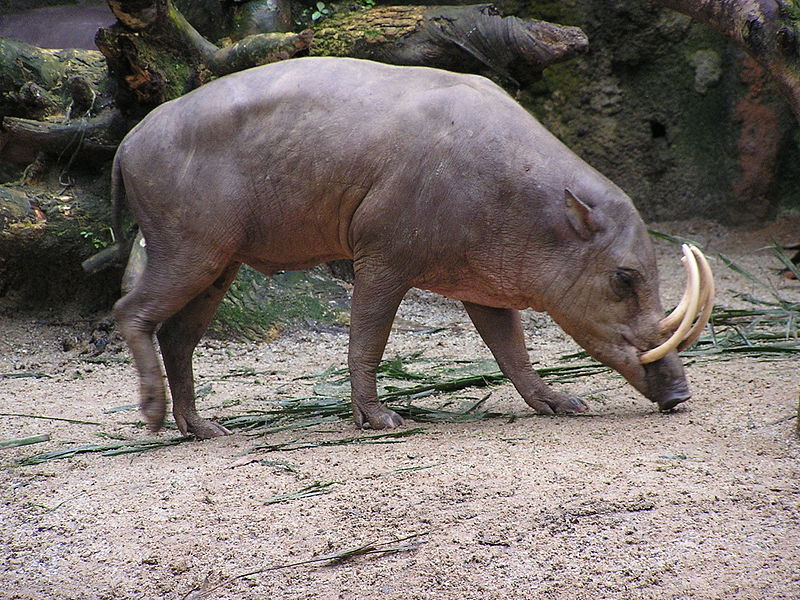 Lories are among the most spectacularly-colored of all Psittacines, with the popular pet-trade species exhibiting an array of “screaming” red, blue, green and violet feathers (please see photo of the aptly-named Rainbow Lorikeet). But there are somberly-colored members as well, typified by the Black Lory, Chalcopsitta atra (sometimes also known as the Rajah or Red-Quilled Lory). But when it comes to lories, “somber” does not in any way equate with “dull”. The jet-black plumage of this beauty is highlighted by a purple sheen and dark orange-red eyes, leaving one with an impression that is not soon forgotten.
Lories are among the most spectacularly-colored of all Psittacines, with the popular pet-trade species exhibiting an array of “screaming” red, blue, green and violet feathers (please see photo of the aptly-named Rainbow Lorikeet). But there are somberly-colored members as well, typified by the Black Lory, Chalcopsitta atra (sometimes also known as the Rajah or Red-Quilled Lory). But when it comes to lories, “somber” does not in any way equate with “dull”. The jet-black plumage of this beauty is highlighted by a purple sheen and dark orange-red eyes, leaving one with an impression that is not soon forgotten.
Range and Habitat
The Black Lory ranges over Western New Guinea (the Western portion of Papua New Guinea’s Vogelkop Peninsula and Western Irian Jaya) and the nearby islands of Batanta and Salawati. Four subspecies have been described.
The little field research that has been carried out indicates that Black Lories favor forest edges and sparsely-wooded grasslands. Isolated tree stands in largely cleared areas are frequented, but they seem rarely if ever to penetrate very far into thickly-wooded habitats. Large flocks, sometimes comprised of several species of lories and other birds, have been recorded.
Considerations for Prospective Owners
Black Lories exhibit many of their tribe’s desirable traits – constant activity, a curious demeanor and a willingness to bond with people if treated kindly – as well as those considered “not-so-desirable” – a loud, high pitched call that they employ most enthusiastically and an often aggressive attitude towards other birds.
In common with related species, Black Lories are quite sensitive to cold, damp conditions. Their size (to 12.5 inches) and high energy levels suit them well for outdoor aviary maintenance, but in temperate regions they must be brought inside during the cooler months. Indoor winter temperatures of 72-75 F are sufficient.
Diet
While Black Lories have been kept on a diet comprised largely of high quality commercial lory food, when caring for these birds at an importing facility years ago I favored a more complex diet.
Following the advice of several older bird-keepers of my acquaintance, I used commercial lory nectar but also provided twice-daily feedings of a fruit/vegetable pulp (pears, various berries, apples, pineapple, carrots, cucumber, honey). To this was added egg food, rice flour and high-protein baby cereal, along with a variety of seeds, kale, sprouts and other greens, and fruit tree branches (with blossoms in season).
Breeding
Although some breeding success has been had in large indoor cages, it is preferable to establish a mated pair outdoors in a quiet location.
Black Lories favor large nest boxes – one measuring approximately 16” x 16” x 22” will do nicely. A typical clutch consists of 2 eggs, which are incubated for 22-24 days. The young fledge in approximately 2 months. Perhaps due to their high metabolisms, Black Lory parents require extra-large quantities of high quality foods.
Further Reading
You can read about the conservation status and IUCN evaluation of the Black Lory here.
Amusing video of a Black Lory bathing.
Black Lorikeets image referenced from wikipedia and originally posted by elvranharris and snowmanradio
 Most parrot aficionados know of the Meyer’s Parrot, but the beautiful green lorikeet bearing the same “first name” is relatively unstudied in the wild, and not commonly kept here in the USA. The Meyer’s Lorikeet (Trichoglossus flavoviridus mayeri), a subspecies of the Yellow-and-Green Lorikeet, differs from many related species in both coloration and social behavior. A forest-dweller confined to a single island, this unique bird deserves the attention of aviculturists now, while wild populations are still relatively stable.
Most parrot aficionados know of the Meyer’s Parrot, but the beautiful green lorikeet bearing the same “first name” is relatively unstudied in the wild, and not commonly kept here in the USA. The Meyer’s Lorikeet (Trichoglossus flavoviridus mayeri), a subspecies of the Yellow-and-Green Lorikeet, differs from many related species in both coloration and social behavior. A forest-dweller confined to a single island, this unique bird deserves the attention of aviculturists now, while wild populations are still relatively stable. That Bird Blog – Bird Care and History for Pet Birds
That Bird Blog – Bird Care and History for Pet Birds



